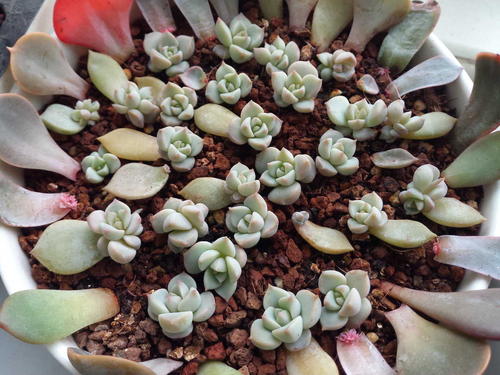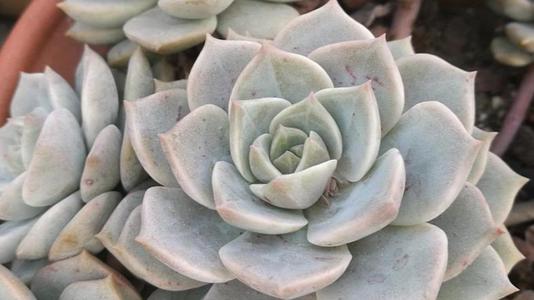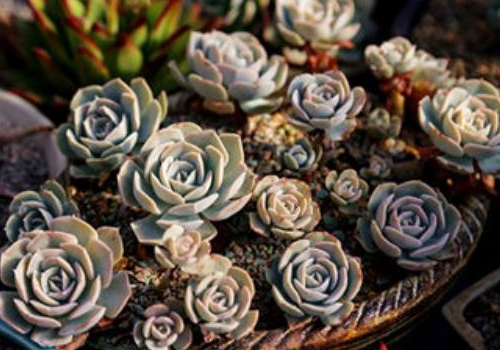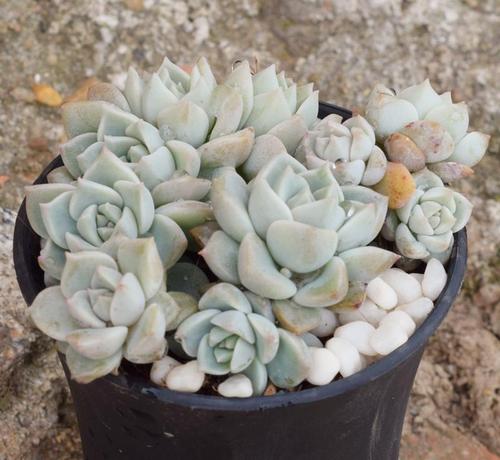Porcelain plant profile
Written by Maggie
Sep 01 2021

Among succulent plants, there is also a kind of fleshy Porcelain plant with thick and round leaves, which looks very unique and beautiful. Many people like it very much. The fleshy Porcelain plant blooms like peony flowers and grows fast. Porcelain plant is also called Hoya carnosa.
Porcelain plant picture
Morphological characteristics of porcelain plant
Stems of porcelain plant (Hoya carnosa) are fleshy, gray-white to gray-green, pale pinkish on the surface, slightly pink in the sun at the tip of the leaves, stalks strong, alternate leaves arranged in rosette, leaves obovate, acute apex, white leaves such as peony blossoms, strong and numerous seeds. Inflorescence of porcelain plant is from the leaf axils extended, half-open flowers, 5 petals thick yellow, transparent color, petals have red dots, blooming in spring.
Growing environment of porcelain plant
Porcelain plant (Hoya carnosa) likes cool, dry and sunny environments and well drained sandy soil.
Distribution range of porcelain plant
Porcelain plant (Hoya carnosa) is originally in France.
Propagation of Porcelain plant
Propagation of the Porcelain plant (Hoya carnosa) mainly depends on side buds, leaf insertion and decapitation. After decapitation, the new buds from the remaining stem and root can be used to extend the offspring. It is easy to grow side buds, and the survival rate is high, and a large number of seedlings can be obtained by leaf insertion.

Porcelain plant - one of the best succulents for beginners
How to grow and care for Porcelain plant
Light
The more abundant the light and the greater the temperature difference between day and night, the brighter the leaf color.In the case of allowable temperature, it is best to outdoor maintenance, to ensure adequate light. The whole porcelain plant is light green or dark green when the sunlight is insufficient or the soil moisture is too much. The leaves of porcelain plants are sparsely spaced and elongated, and the upward growth is accelerated. A porcelain plant seriously affects the ornamental quality, and may even die because the photosynthesis of the plant is blocked.
Moisture
Due to the high water content in the plant, the Porcelain plant (Hoya carnosa) is prone to decay in excessive humidity. Do not overwater. In order to avoid root water deposition, it is best to choose the pot with drainage holes at the bottom, beginners can choose the red pottery pot with good air permeability when planting; Use with caution glass containers that absorb heat and have poor air permeability.
Reference watering amount: 10 days or so, watering thoroughly each time. The watering frequency for porcelain plant (Hoya carnosa) can be increased or decreased according to the climate difference of different regions and seasons.
Soil
It is advisable to use the sandy soil with good drainage and air permeability for the removal of excess water and the growth of porcelain plant roots. We can use leaf rot soil, sand soil and garden soil each 1/3 preparation. Replace the pot every 3~4 years in the spring and cut off the dead old roots.
Porcelain plants (Hoya carnosa) can withstand -4 degrees low temperature for 2 hours. Porcelain plants stop growing when the temperature is too high (more than 35 degrees Celsius) or too low (less than 5 degrees Celsius) in winter and summer. At this time, watering should be temporarily reduced or stopped, and the frequency of watering should be resumed when the temperature is suitable. Pay attention to ventilation during high temperature in summer to prevent prolonged exposure to the sun to avoid sunburn.
Trim
The dry old leaves of porcelain plants (Hoya carnosa) should be removed in time at ordinary times so as not to accumulate and cause bacterial breeding. When the porcelain plant is overgrown or overgrown, it can be shaped by pruning the top branches and leaves to control the height of the plant, so as to maintain the graceful plant shape. The top part of the cut can be inserted into the sandy basin soil after drying the wound to take root and become a new plant. The stem and branches at the bottom can produce more lateral buds.
Fertilizer
Fertilizer should not be too much, especially nitrogen fertilizer, otherwise it will cause porcelain plants to grow barren, the leaf color is not red. Apply a monthly thin fertilizer based on phosphorus and potassium.
Put porcelain plants (Hoya carnosa) in a ventilated environment for maintenance, otherwise it's easy to get sick. Its suitable temperature for growth is 15-25 degrees, not less than 5 degrees in winter; In the porcelain plant growing season watering thoroughly, dry air can sprinkle water around the plant, but the leaf, especially the center of the leaf should not be water, otherwise it will cause rotten heart; Fertilization during the porcelain plant growing period is usually about once every 20 days. Growing season is the spring and autumn when the basin soil is completely dry before watering, summer needs shade, and reduces watering. In winter, porcelain plants are placed indoors in the sun for maintenance.
Plant diseases and insect pests of porcelain plant
The insect pests of porcelain plants (Hoya carnosa) are mainly scale insects. More than 60% of plants bought from flower markets had scale insects in their roots. Early insect pests are common in the root or plant center, found after the insect pests need to be immediately isolated from other porcelain plant, cut off the root breeding scale insects, can be sprayed in the affected area of the protection of the flower or root irrigation to kill (chlorothalonil, carbendazim and other fungicides do not have insecticidal effect). Extinction of scale insects can take several cycles. To prevent the incorporation of small amounts of carbofuran or tranchandan into the compound soil.
The most common diseases of porcelain plants (Hoya carnosa) are plant blackness (that is, the plant parts turn black and rot, mostly in the roots), most in the summer, usually due to poor ventilation conditions and high humidity and heat, but sometimes can be caused by scale insects. After being found, it should be quickly isolated from other porcelain plant. At the initial stage, the rotting parts of the porcelain plant can be thoroughly cut off. A little fungicide (chlorothalonil, carbendazim, etc.) can be smeared on the incision. After drying the incision, it can be inserted into loose sand soil to re-root. If the black rot of a porcelain plant has spread to the point of growth, it is considered dead. Discard porcelain plants as soon as possible to prevent infection. Other diseases (bituminous coal disease, etc.) can be treated by spraying diluted chlorothalonil, carbendazim and other fungicides. Prevention can be mixed with soil with a little chlorothalonil, carbendazim and other fungicides.

Latest Updated
- Benefits of Bugleweed - 7 Science-backed Health Benefits
- Bugleweed Dangers & Side Effects - Is It Poisonous?
- How to Plant Evergreen Trees - What You Should Know
- When to Plant Evergreens - Grow Guide for Evergreen Trees
- 12 Wonderful Evergreen Shrubs for Your Garden
- 12 Popular Evergreen Plants with Pictures for Beginners
- When And How To Prune A Lilac Bush Like a Pro
- How to Grow & Care for Lilac Vine (Hardenbergia Violacea)
- Japanese Lilac Tree (Syringa Reticulata) Care & Propagation Guide
- Shumard Oak Pros and Cons - What to Know
Popular Articles
- Winter maintenance of Antirrhinum Majus
- How to Grow Terminalia Mantaly Tree
- How to Grow and Care for Crossostephium Chinense
- How to grow Antirrhinum Majus in spring
- Peristeria Elata (Dove Orchid) Profile: Info & Care Guide
- Underwatered Snake Plant (Sansevieria Trifasciata) - Signs And How To Fix
- How to Care for Brazilian Jasmine Plant (Mandevilla Sanderi)
- How to Grow & Care for Graptopetalum Purple Delight in Summer
- Rosa Chinensis (China Rose): Plant Growing & Care Tips
- How to Care for Baby Sun Rose (Aptenia Cordifolia)
